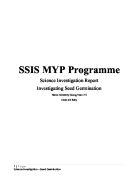Controls
You need to keep the time of the reaction the same, or else it wont be a fair test. You can do this by using a timer and noting down the time.
You need to keep the batch of potatoes the same from which the enzyme comes from because the enzymes wouldn’t been the same and it would make the test unfair. You can do this by just simply using the same batch of potatoes.
You need to keep the amount of Hydrogen Peroxide the same, you can do this by measuring it out in the measuring cylinder. You need to keep it the same so the particles don’t become too much.
You need to keep the amount of enzymes the same because of the particles, they could become too much or too little. You can keep this fair by weighing the enzymes on the balance.
Conclusion
My results show that at the low temperatures the reaction is low and the same with the high temperatures. But when the temperature is average the reaction is high. The graph shows that the reaction rose at 30° the dropped the oxygen levels.
The 0°c temperature ranged from 4ml-10ml (per minute), the average reaction level was 6ml. The 20°c temperature ranged from 12ml-44ml, the average reaction was 26ml. The 30° temperature ranged from 70ml-134ml, the average for this was 110ml. The 42° temperature ranged from 6ml-20ml, the average score was 12ml. The 51° temperature ranged from 8ml-72ml, the average score was 22.4ml.
Explanation
The peak temperature for the reaction is 30°. It is the peak temperature because it has the most energy at this point. It does this because the higher the temperature the more energy the particles have, so the particles have more energy, so they collide more and they make more gas. This is because enzymes have a part called the active site, molecules with the same shape as the active site, molecules with the same shape as the active site collides with the enzymes active site joins them up then the substrate separates them to make h2o and o2. This is the lock and key method.
The lock and key diagram:
After 30° the shape at the active site is changed because of the heat. This causes the substrate and enzymes to connect together. This causes less gas to be made because they cannot react. This is when an active site changed, it is called denaturing.
At 30° it made the most gas because there was more energy in the particles and they moved the most. They collided more, made more gas and reacted the most. It does this without denaturing the enzyme.
Evaluation
In this part of the evaluation I will be listing the improvements that could have been done to the apparatus and the techniques that could have been changed. This would be an improvement to the test because then the results would have been more accurate. The first improvement would be that we didn’t check the temperature of the enzymes and substrate. I should have used a thermometer because the particles could have been too cool and that would cause the particles to have less energy and bump around less, therefore having less gas. Secondarily, I didn’t scrape all the enzyme into the flask. I should have measure the enzyme into the flask. Less enzymes being used means less collision, less gas and less particles are happening because less enzymes were used. I also didn’t dry the flask after I washed it and used it again. The remaining bits of water in the flask mixed with the enzyme and substrate. I should have dried it with a paper towel. Finally, I didn’t use the same equipment throughout the tests, this might have cause the results of the tests to change for various reasons.
Looking at my results on my graph I have noticed various temperatures which are reliable and unreliable. I’ll explain why I think some of the temperatures are unrealisable.
0°c and 42°c are reliable because the data’s average is near the highest and the lowest temperature reading. There is no overlap from the error bar.
52°c and 30°c are not reliable because there is a big gap between the error bars highest and lowest reading compared to the average. I think its unreliable because the gas syringe we used was different every lesson, sometimes they were very loose and gave high readings and some were very stiff and gave low readings.
If we used temperatures below 0°c and above 50°c-100°c we could have worked out whether or not the pattern is the same as the pattern on my graph. This would have been an improvement because my readings would be more accurate. At the moment we have a pattern that high and low temperatures have low reaction and in the middle temperatures have a high reaction but we need to be certain that temperatures below 0°c the reaction goes down and above 30°c it denatures.
We could heat enzymes to 100°c, then cool it down to 24°c then test it to see if it still works and doesn’t make gas (denatured). If it does not work it will not be denatured and will still make gas.
The number of degrees was more than adequate at 10°c. The range of the temperatures was fine for this investigation I choose to carry out.








